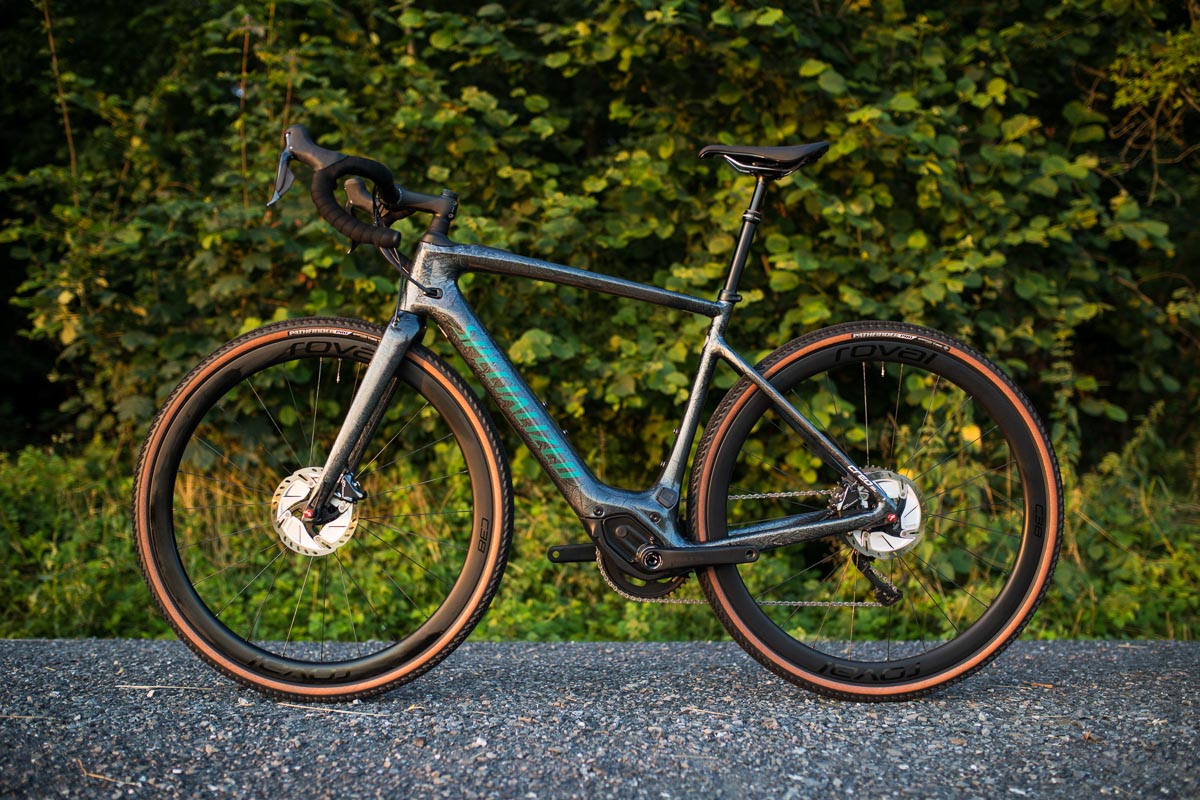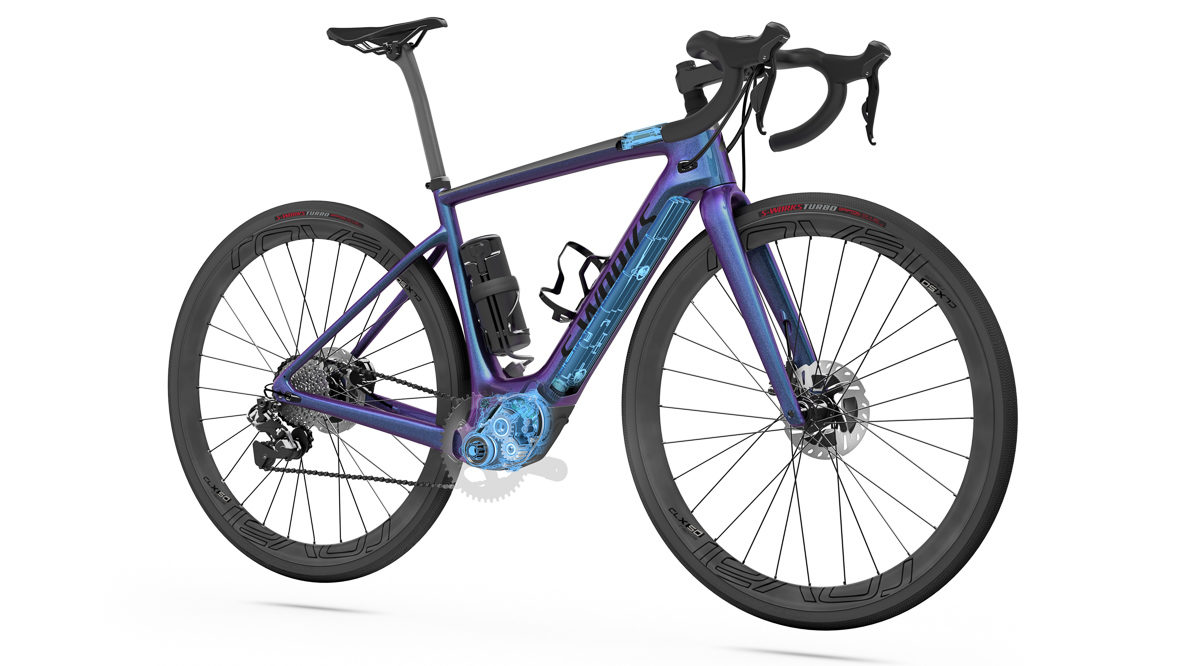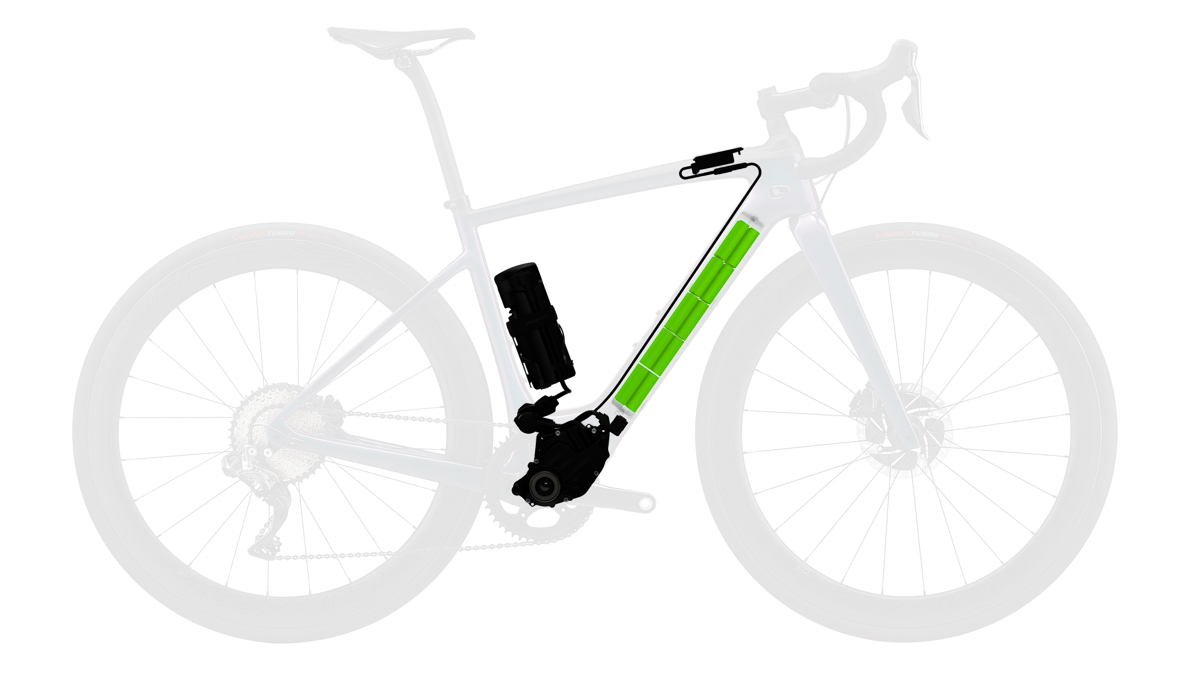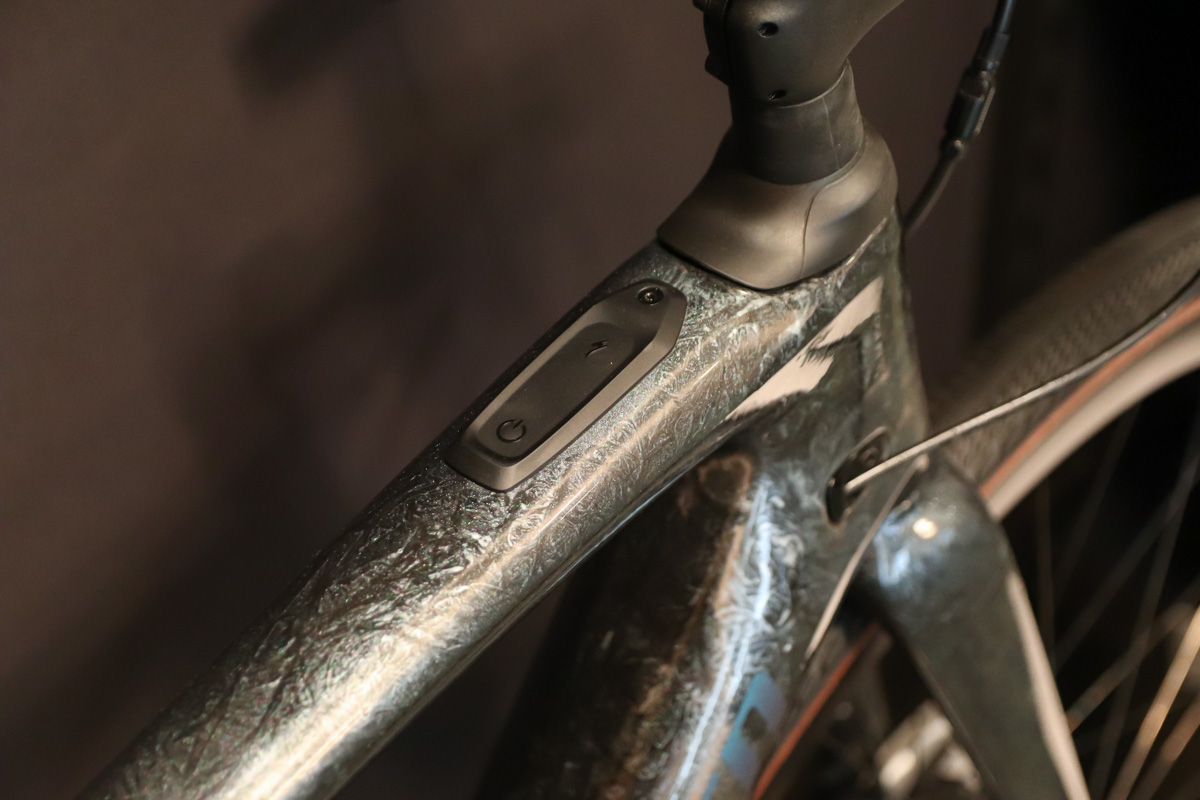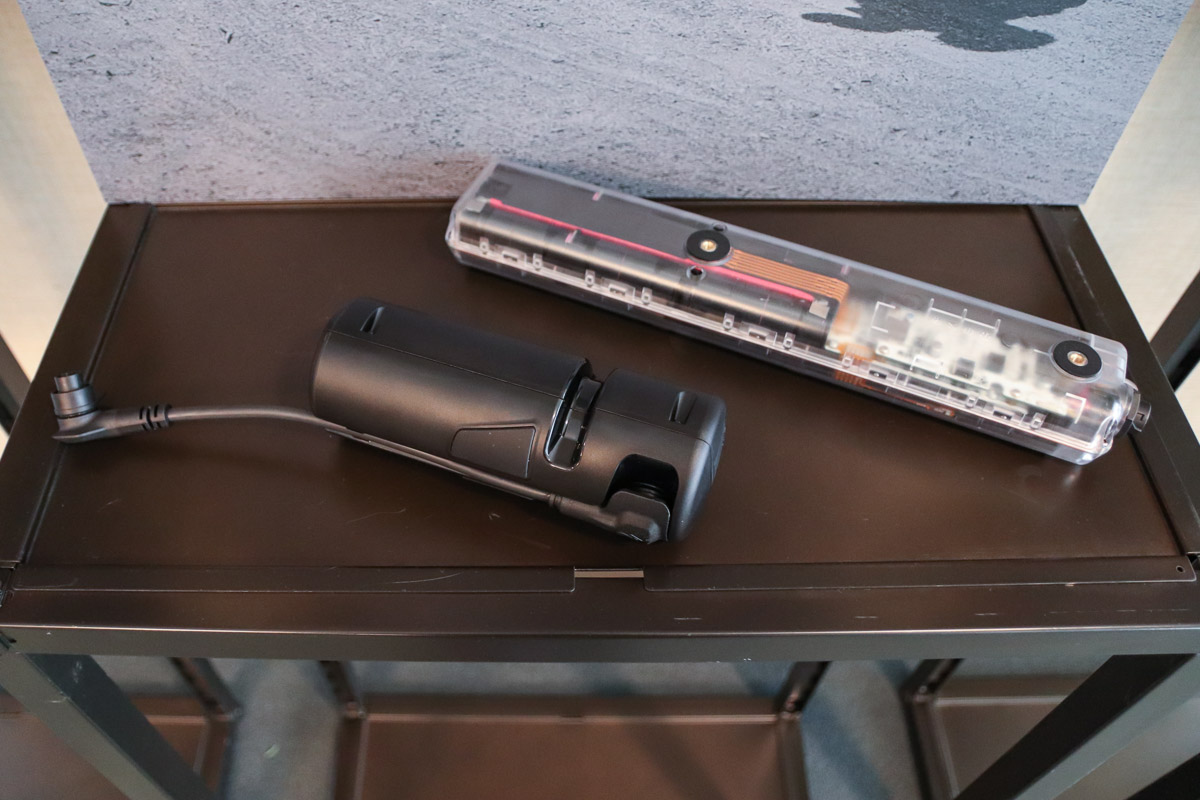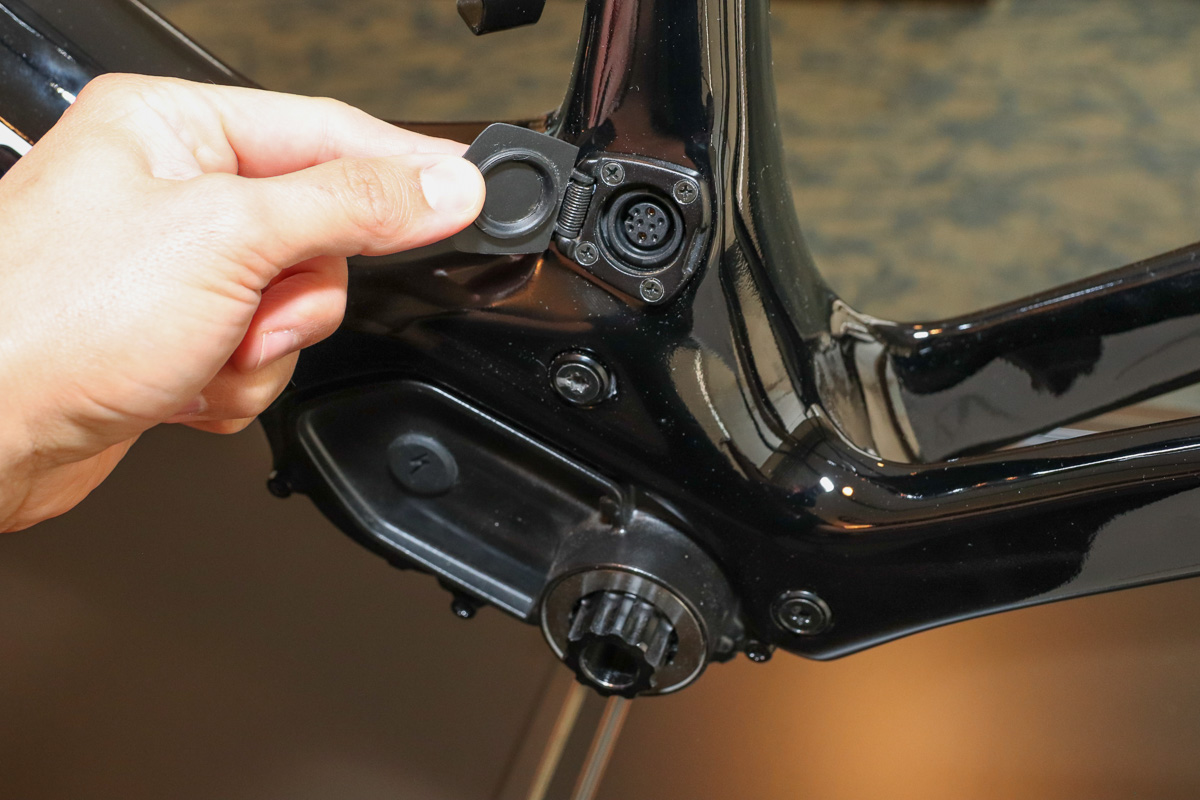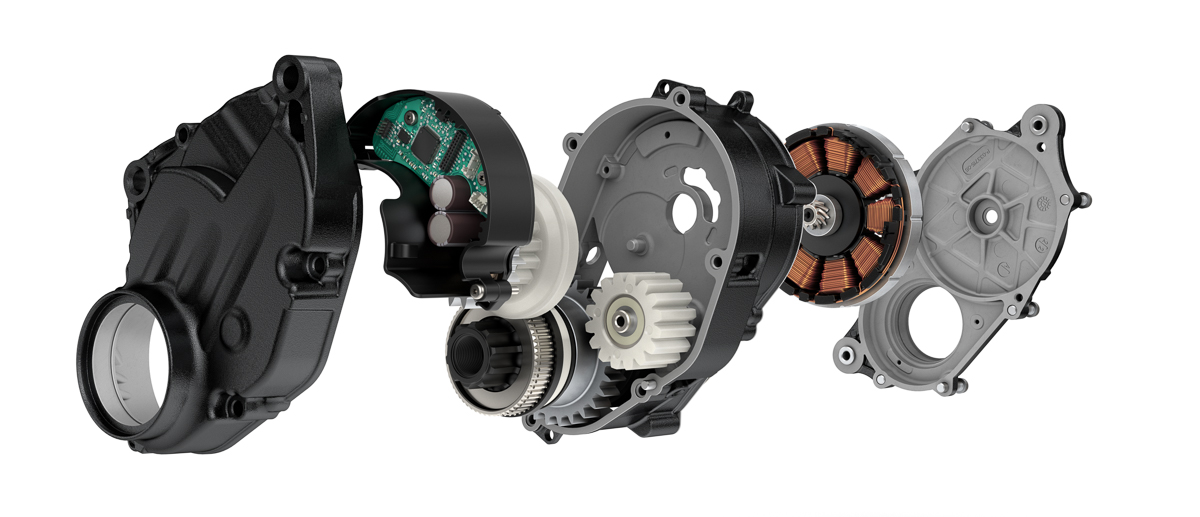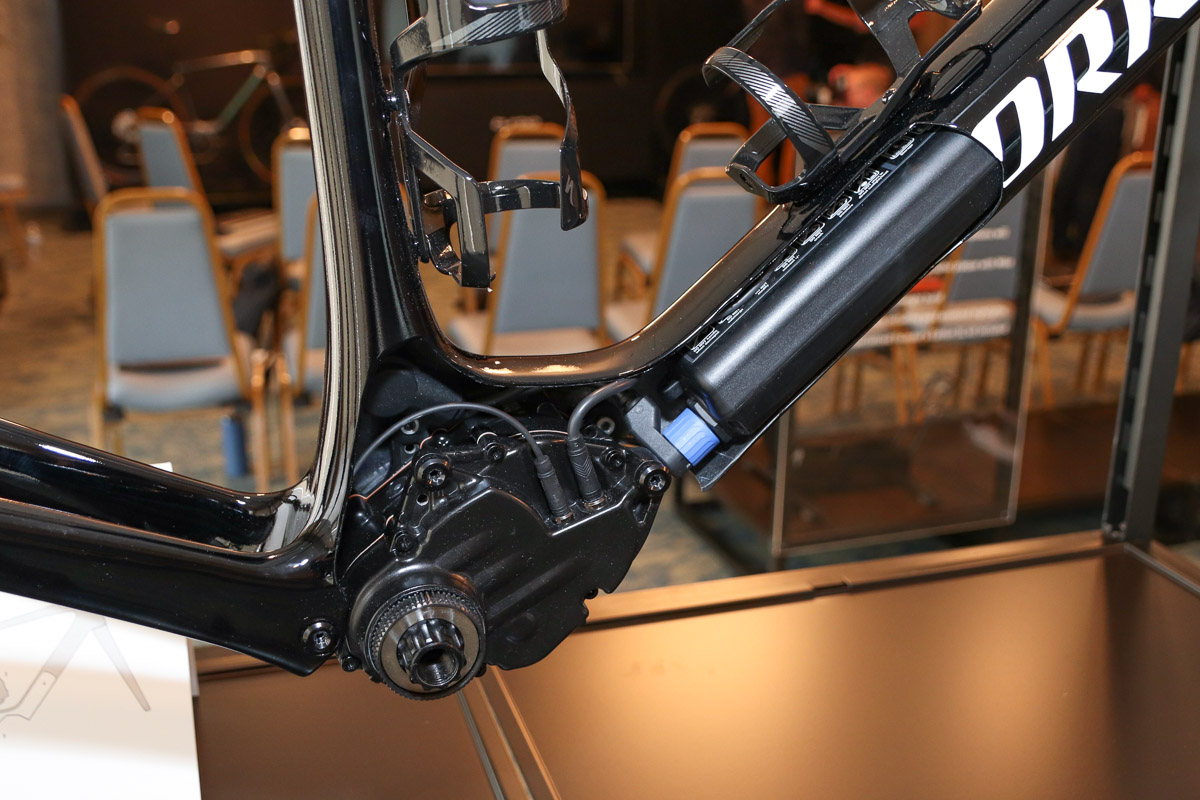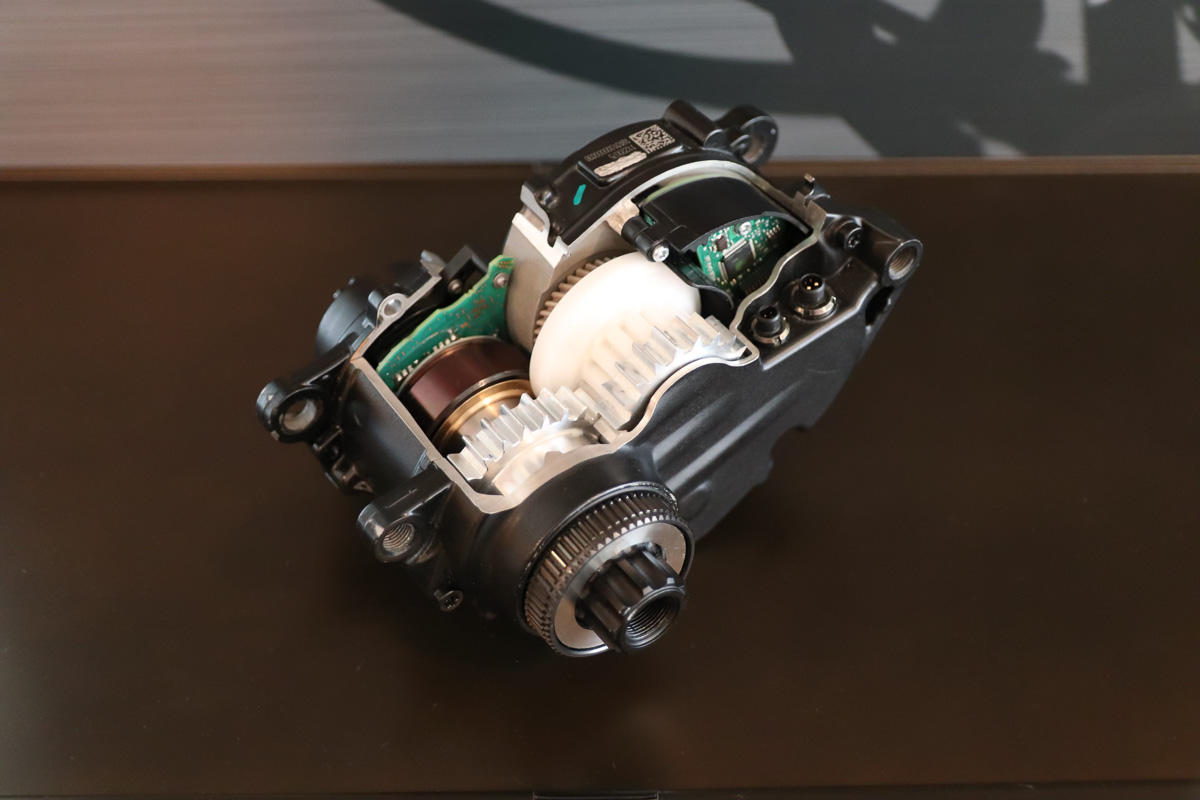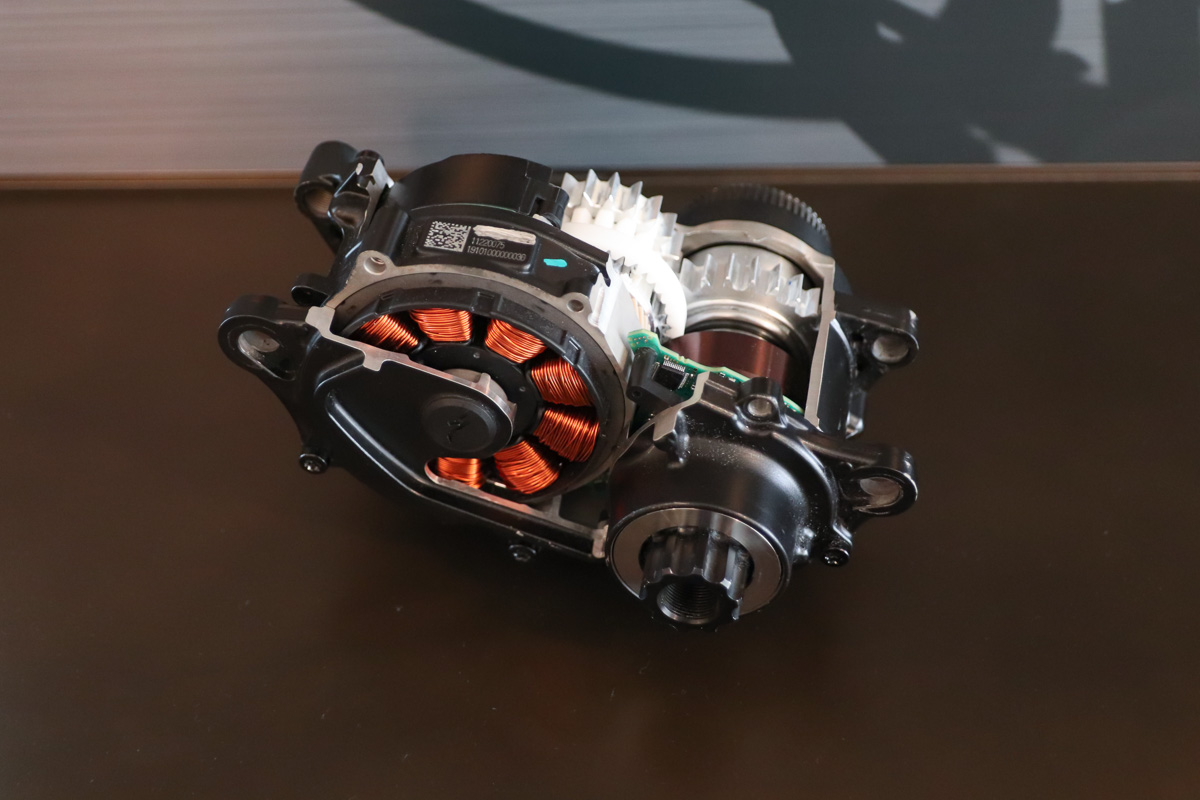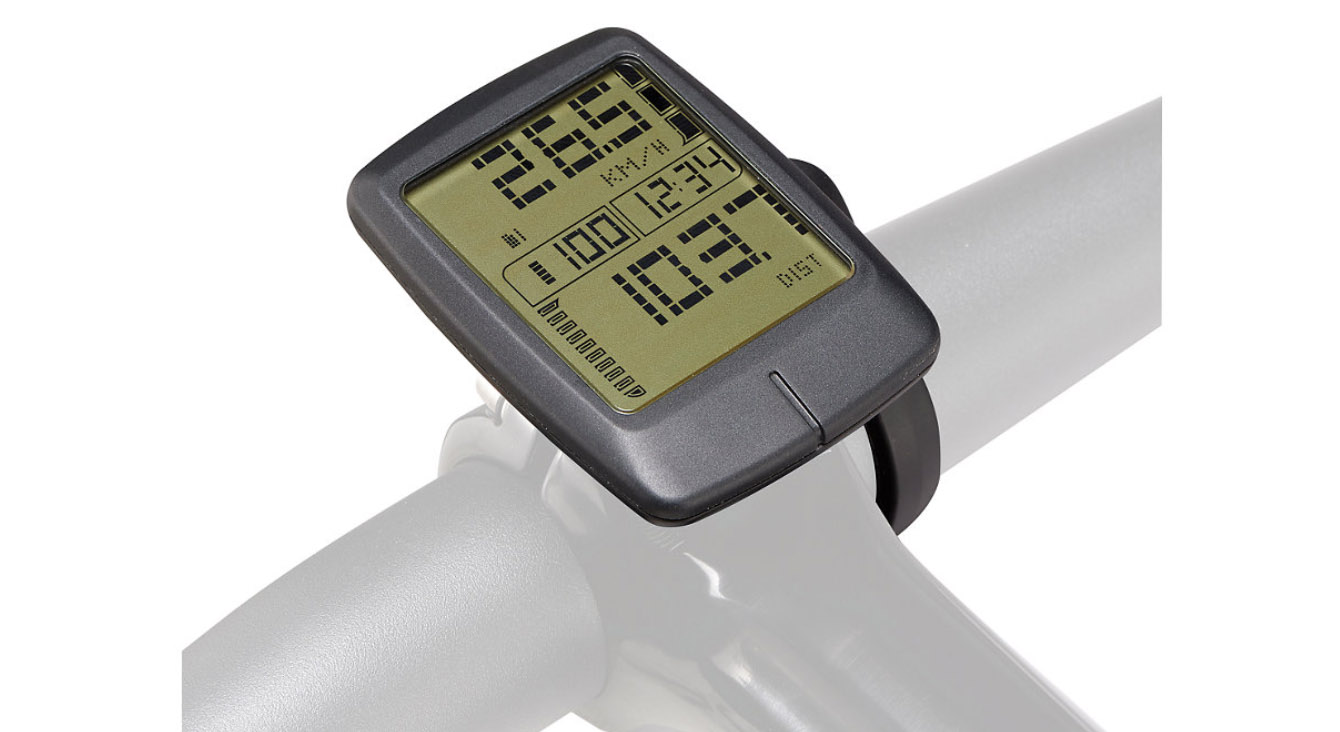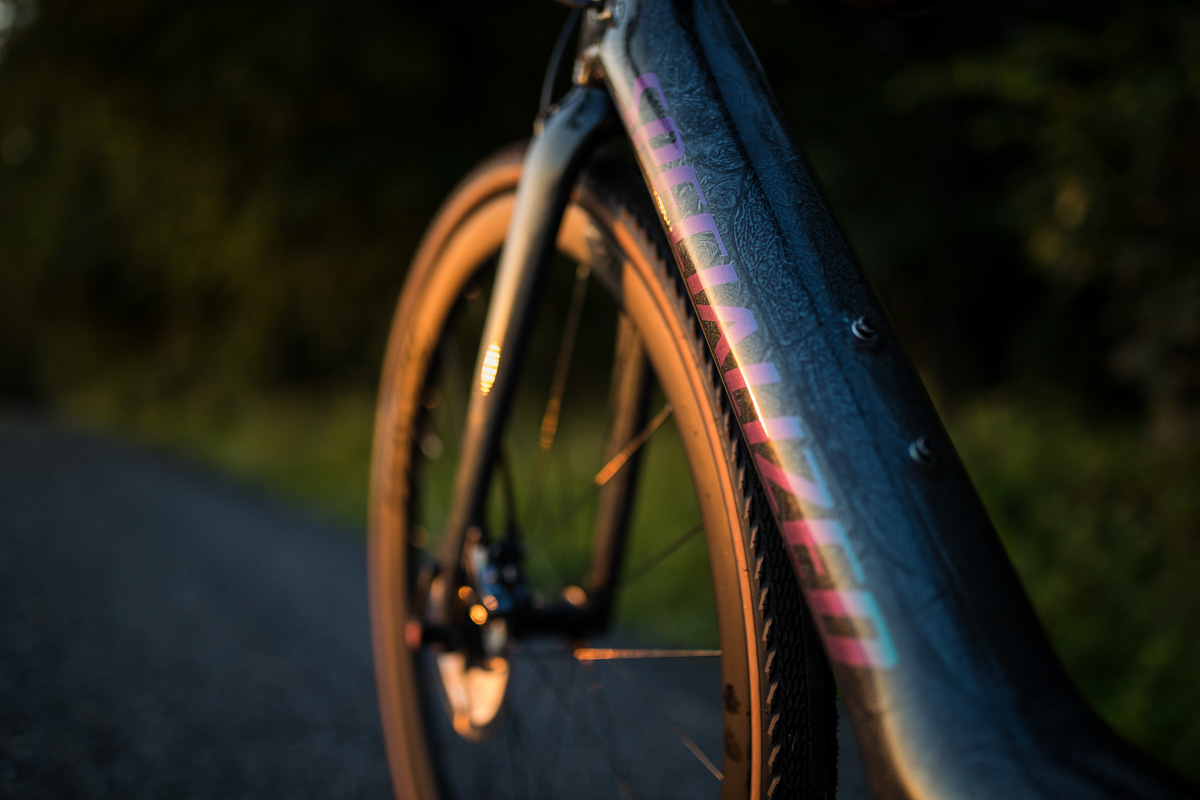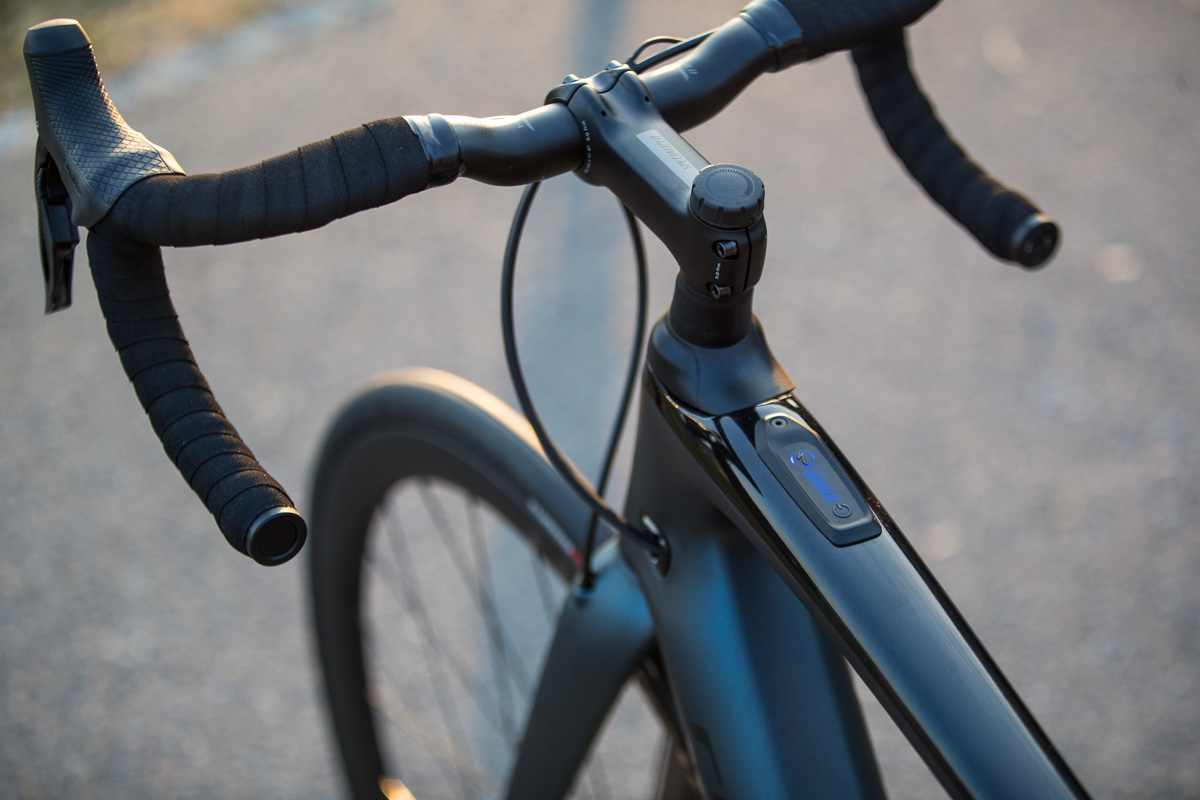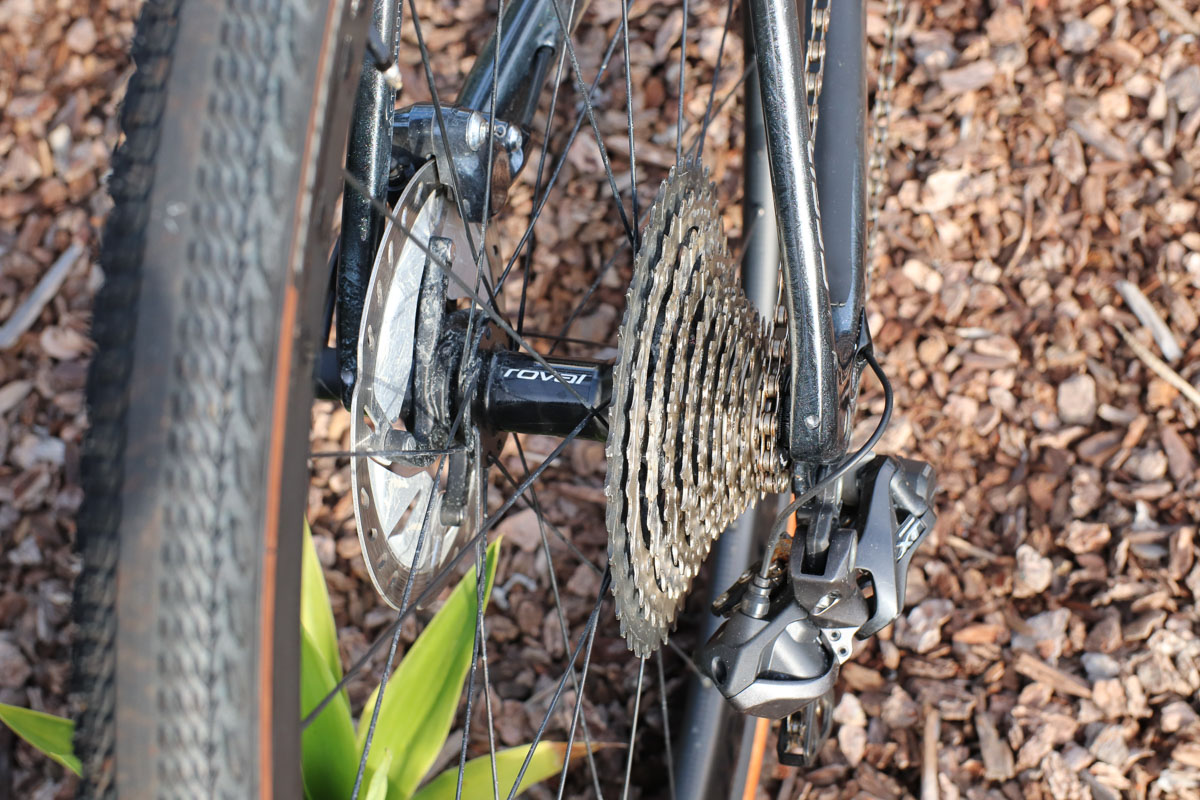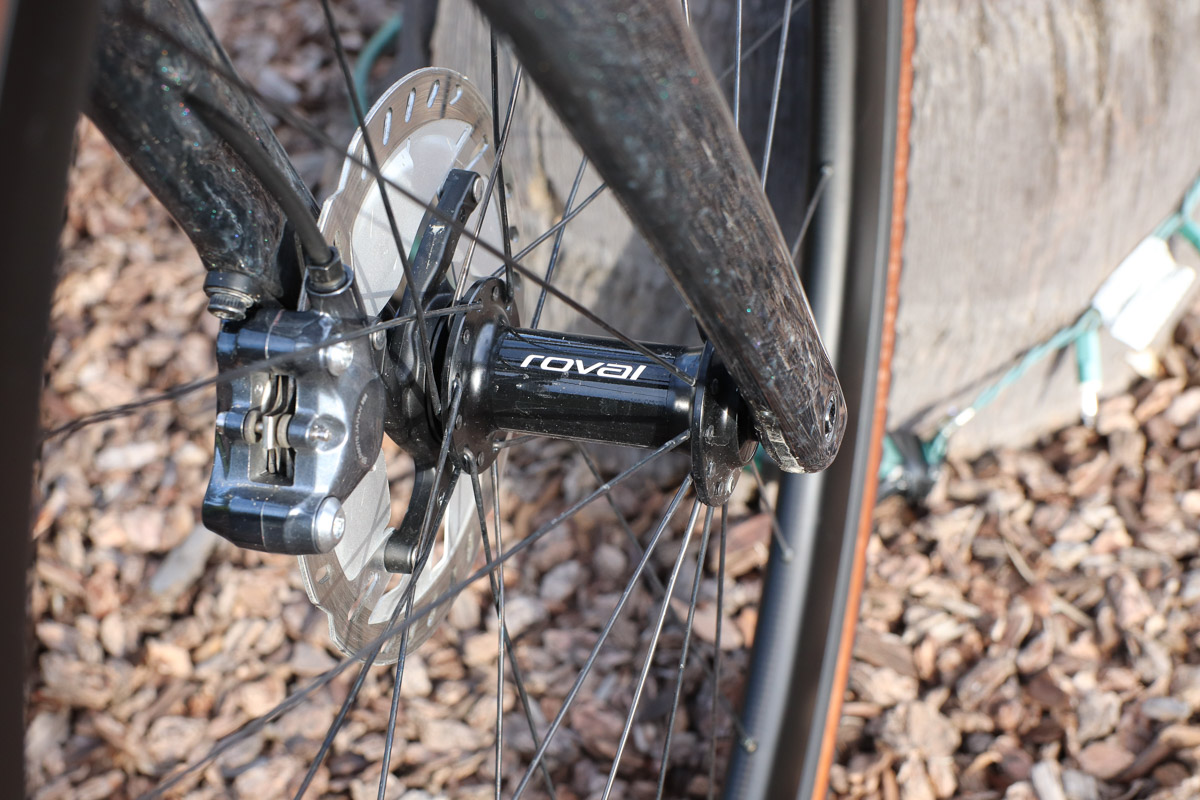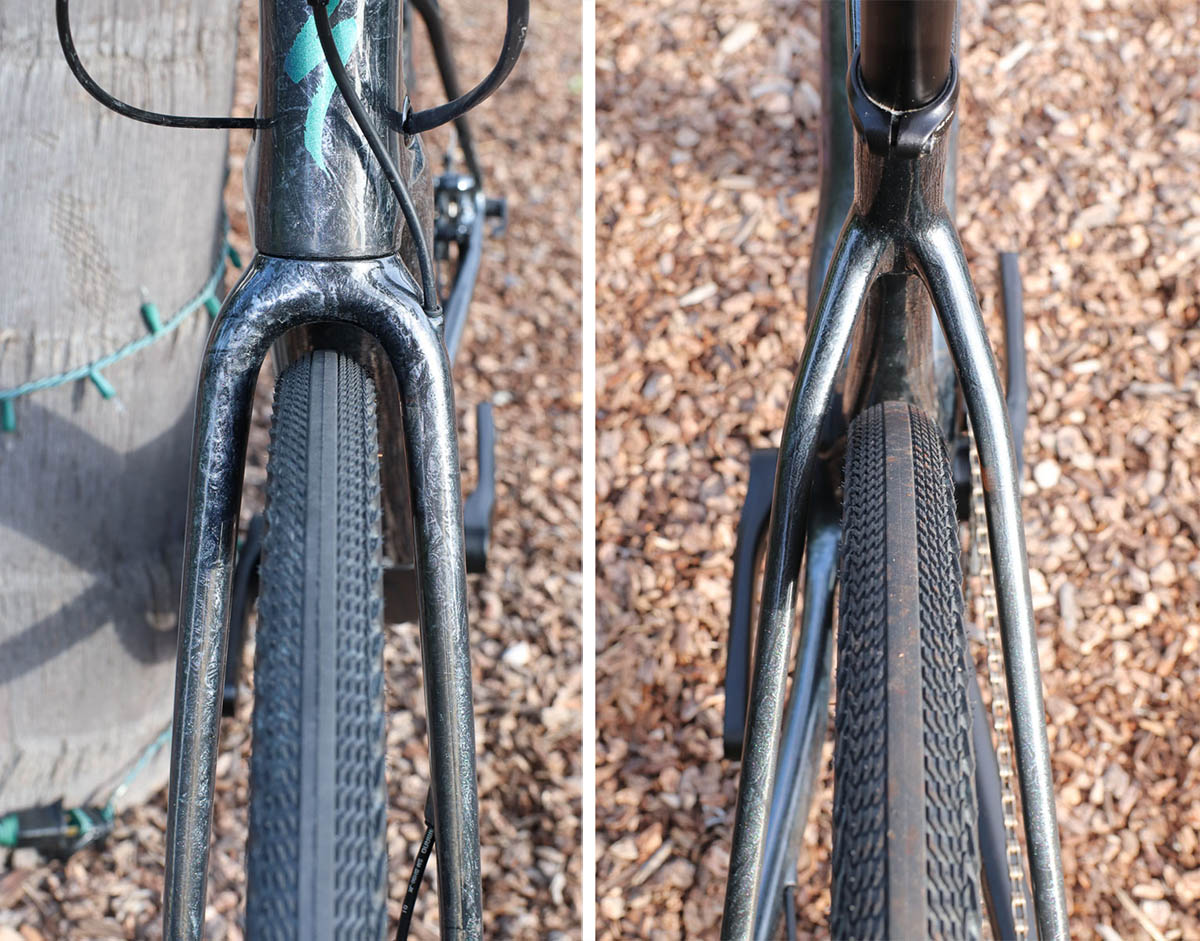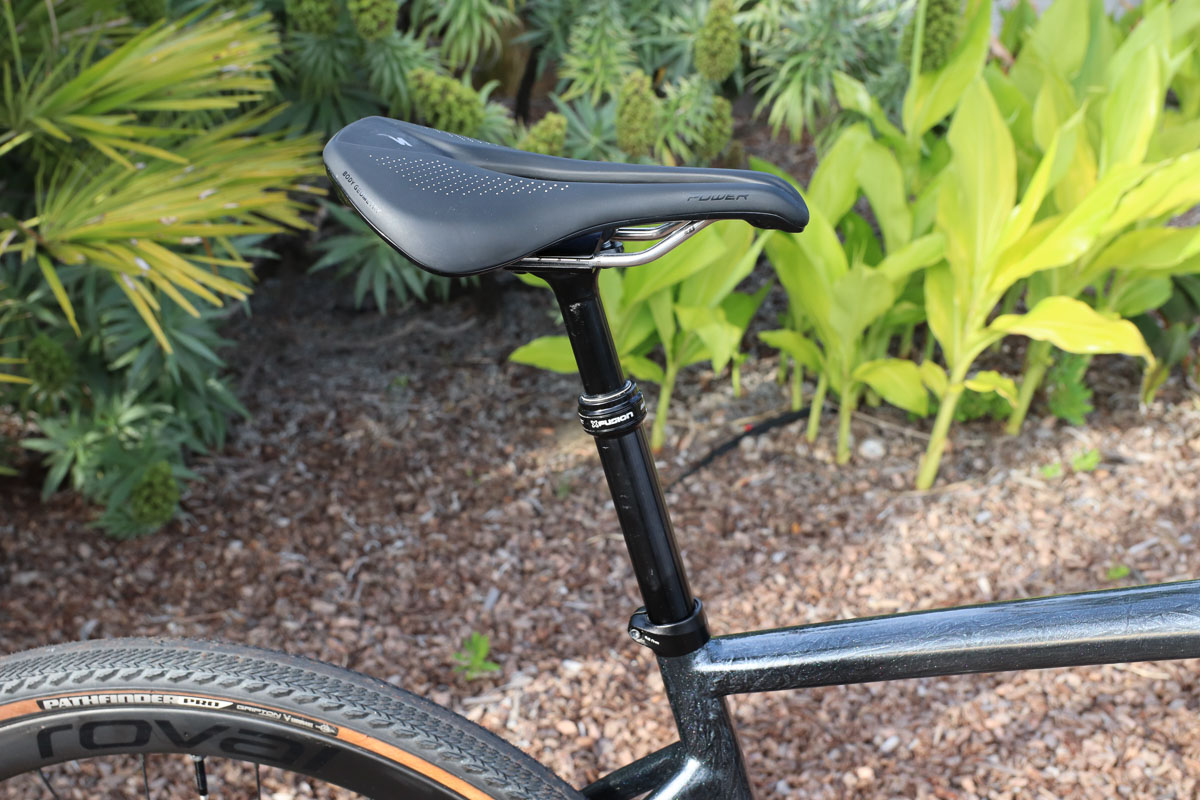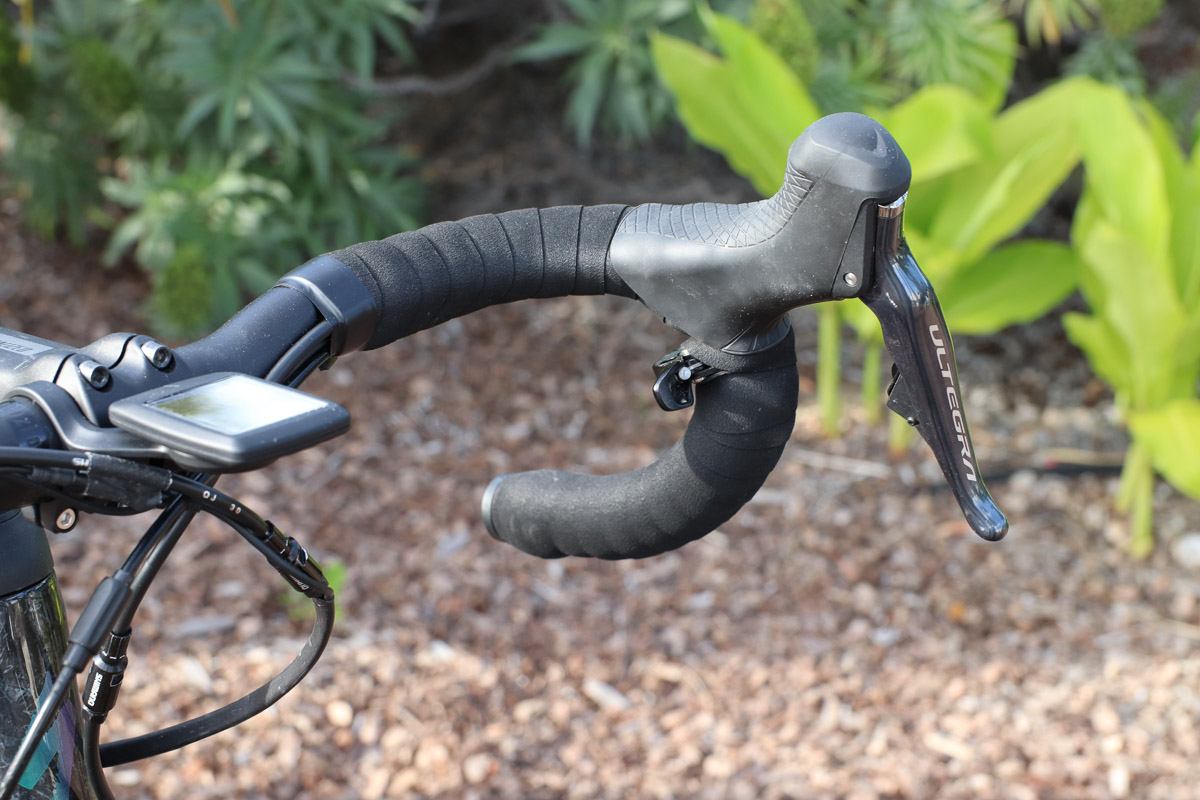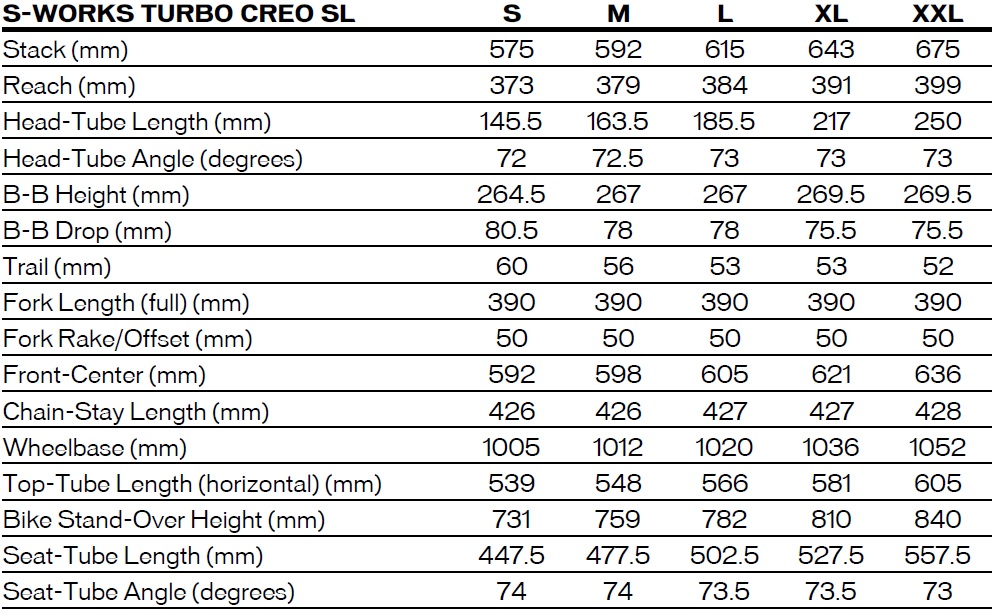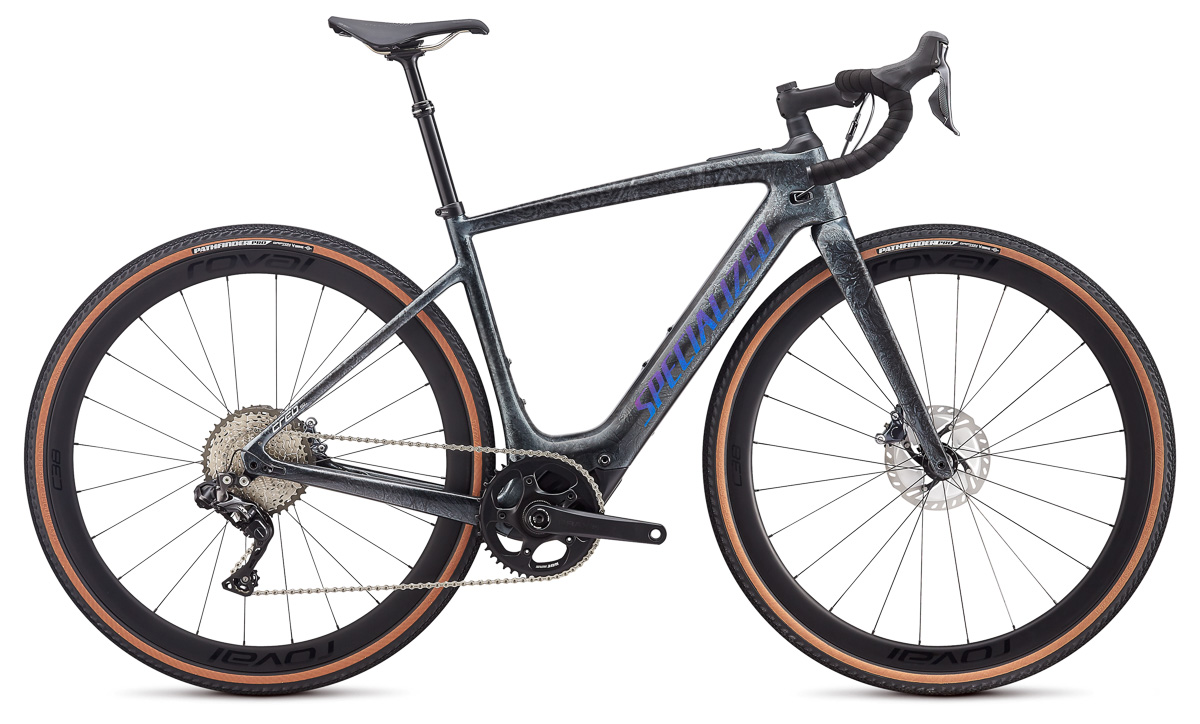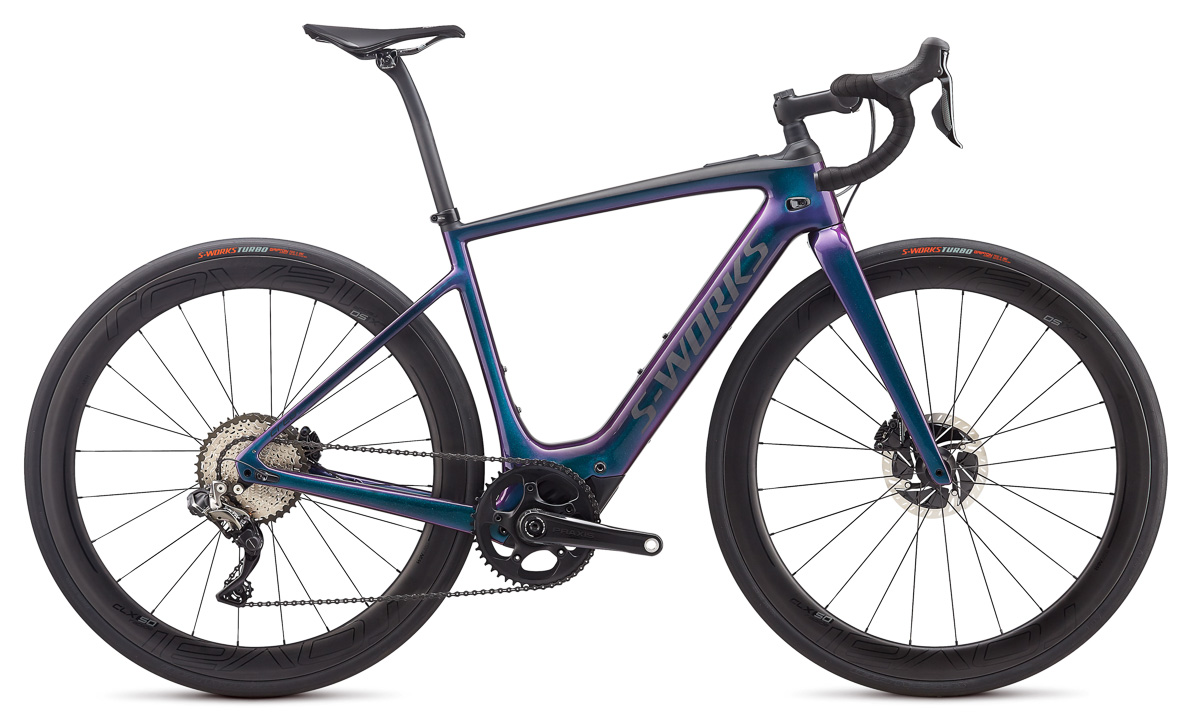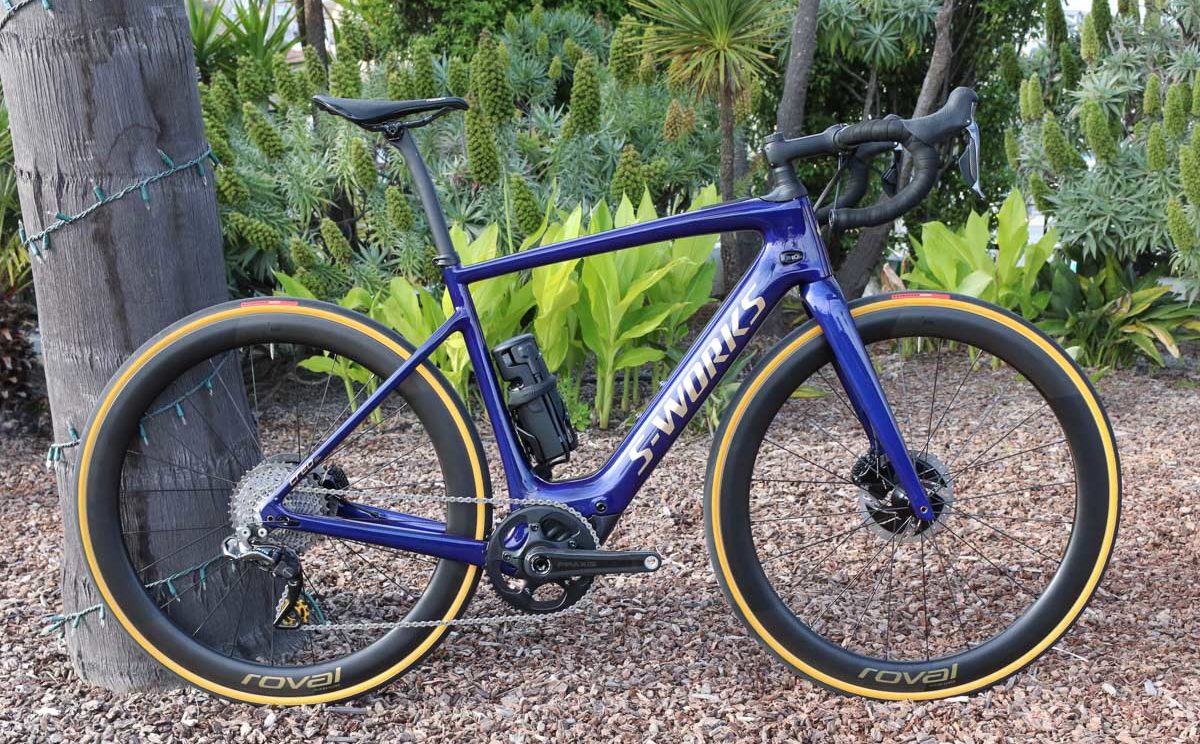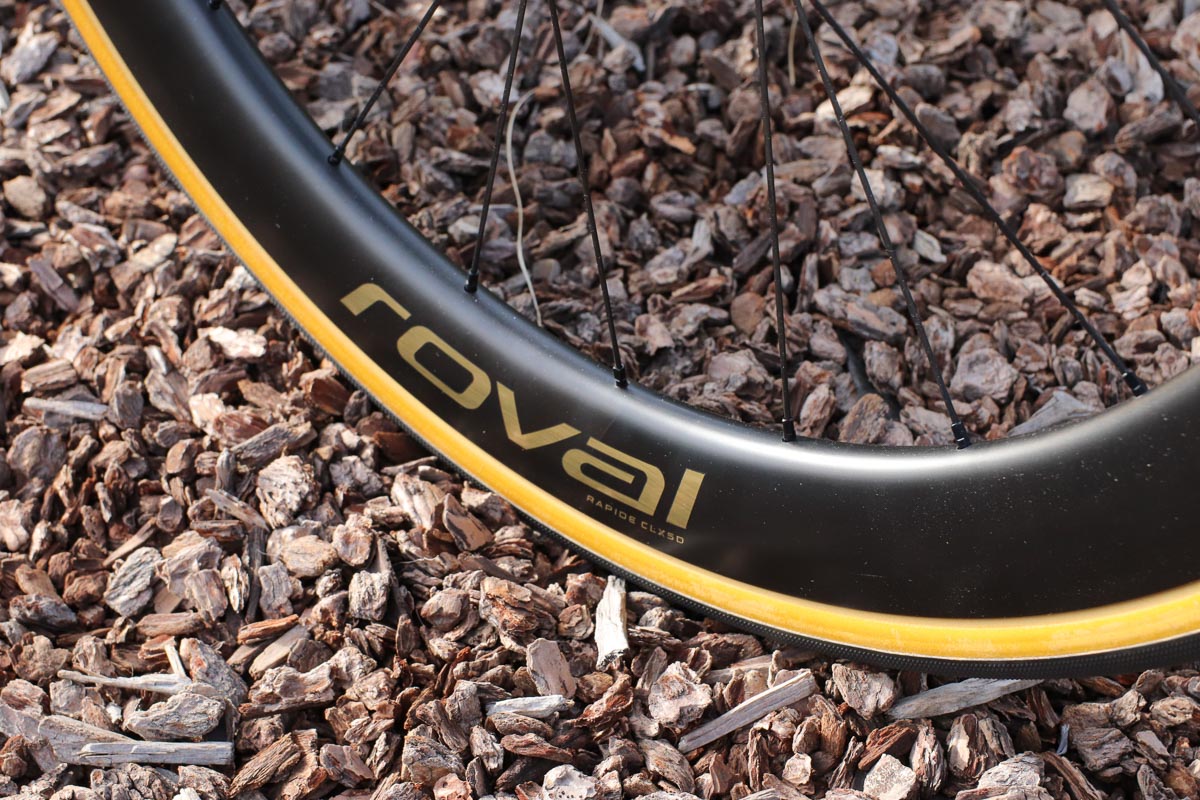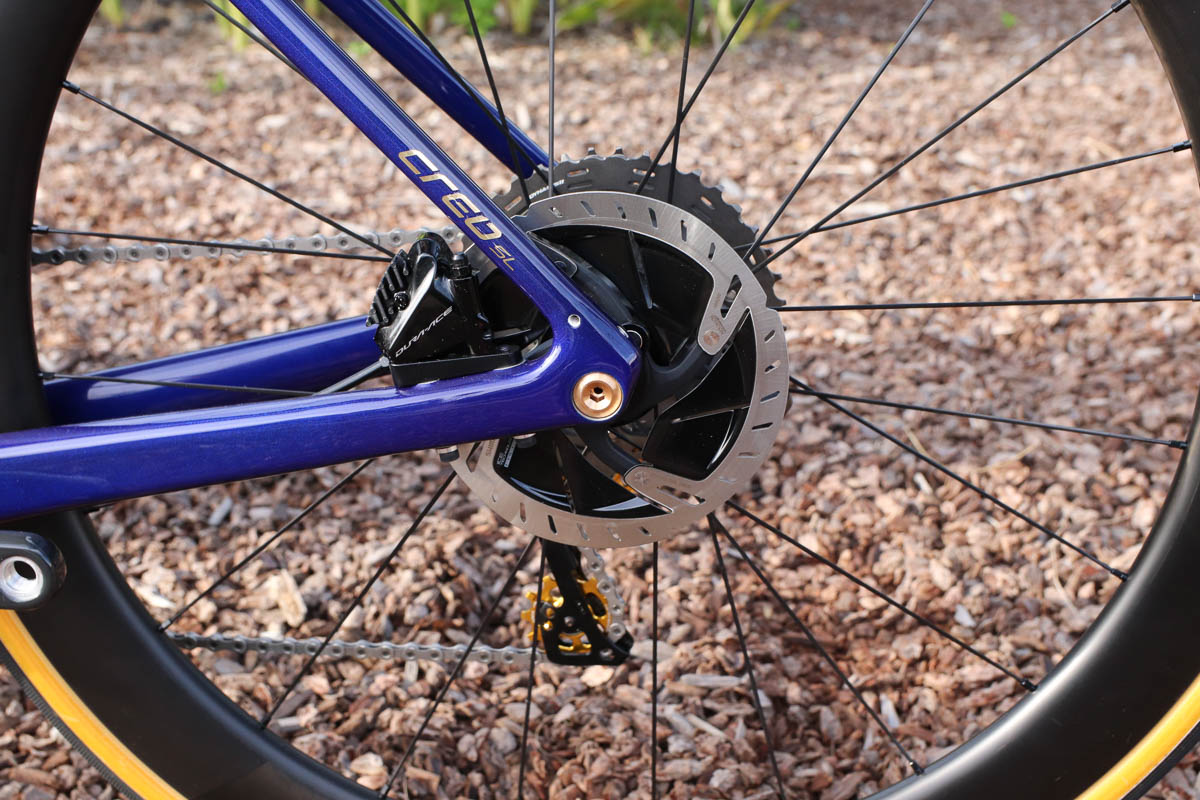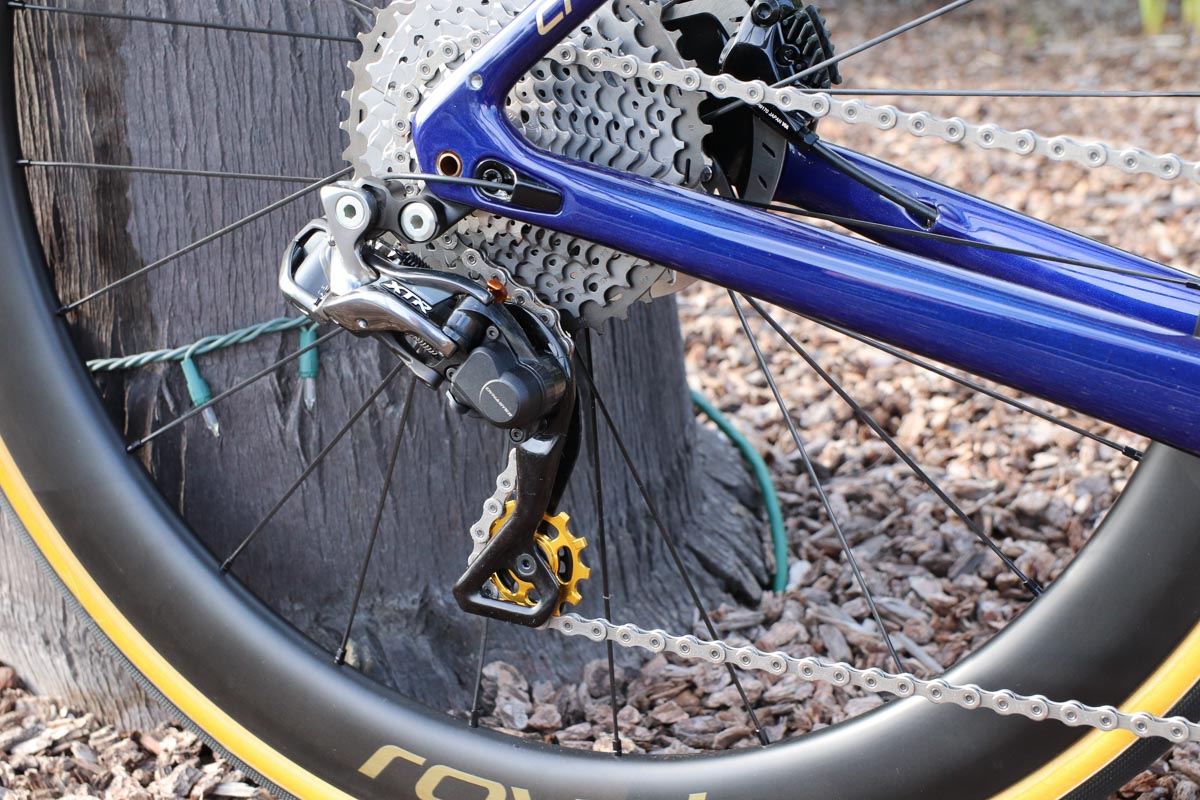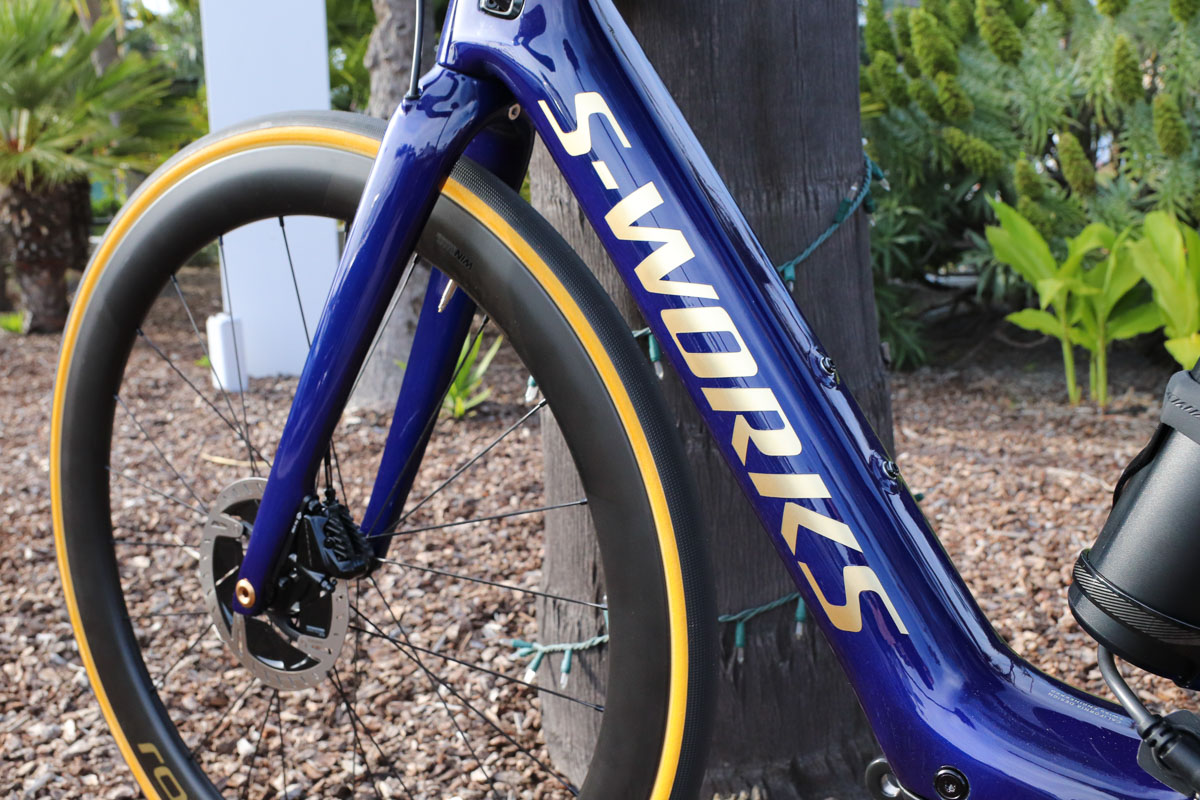Specialized officially entered the e-road and e-gravel segments today – with a single new bike offering. Called the Turbo Creo SL, the new bike has wide tire clearance to tackle a variety of terrain, along with the Future Shock 2.0 suspension system. The motor and battery system have been designed from the ground up for an ultra compact design and light weight – and surprisingly long range. The new frame also uses Boost spacing for road, a new standard that might take hold for future e-road and e-gravel bikes.
Specialized Turbo Creo SL road and gravel e-bike
Specialized is no stranger to e-bikes, and teased us just a few days ago about a potential new e-road offering. Today it became official, with the announcement of the all-new Turbo Creo SL. The new bike is made for both road and gravel riding, using a motor and battery system that was completely developed in-house at the Specialized e-bike facility in Switzerland. We attended the official launch in Santa Cruz, CA, where we got the full download and two days of intense riding on and off-road.
At first glance, it’s hard to tell that you’re even looking at an e-bike. The downtube is about the same diameter as an old fat-tubed aluminum Cannondale, which houses the 320Wh internal battery pack.
The internal battery is shown above (right), along with a great new option that Specialzed just introduced – a 160Wh Range Extender battery that mounts into any standard bottle cage and weighs 1kg. The obvious benefit is that this increases battery life by 50%, and allows you to swap out Range Extenders for effectively unlimited ride distance. The Mission Control App allows you to control multiple battery modes, so you can pull from both batteries simultaneously, or one at a time.
The range extender plugs in to a port in the seat tube, allowing for battery swapping in less than 30 seconds. The added bonus is that the Range Extender battery solves a huge issue for e-bikes – the fact that you can’t fly with them due to battery size limitations. The Range Extender is small enough to comply with the flight regulations, so all you need to do is remove the downtube battery (at a Specialized dealer) and pack a couple Extenders for your trip.
Note: You can carry two extenders on the bike at one time, but only one may be plugged in at a time. Also – the new motor system is 48 volt vs 36 volt for previous Specialized e-bikes, meaning that the Range Extender is not backwards-compatible.
The motor is an all-new unit developed by Specialized in their Swiss e-bike facility. Called the SL 1.1 motor, it features a magnesium housing and weighs 1.95 kilos (4.3 pounds), placing it at the top of the heap for e-bike motor weight. It provides up to 240 watts of assist and 35NM of torque. The Creo is classified in the US as a Class-3 pedal-assist bike, providing motor power up to 28mph.
The motor has four modes: Off, Eco, Sport, and Turbo. Eco matches your effort at up to 30% of the motor’s power, Sport matches up to 60%, and Turbo matches up to 100% (240w). It’s worth noting that this tuning choice and the motor’s torque output are quite a bit different than some of the competition. For example, the Turbo mode from Specialized feels roughly equivalent to the Eco mode used in the Shimano STEPS E8000 system aboard the BMC Alpenchallenge AMP Road (which gives a 300% assist in Boost mode). We’ll get into more detail in our forthcoming ride review, but the short version is that the two systems feel very different.
With the motor turned off, the internal drive system is completely decoupled, resulting in a claim of zero motor drag.
The graph above shows the motor tuning of the new SL 1.1 system. This requires some technical explanation, and is a key part of the Specialized philosophy on e-bikes.
According to Specialized, while you can do some tuning of the motor’s behavior via software in the Mission Control app, the motor design itself is the primary driver for how it behaves. In short, the manufacturer has to decide what cadences they want to optimize for – and they can’t optimize for everything. Specialized made the decision to tune the power curve for maximum efficiency of the motor and to be “in tune with a natural cadence”… meaning that the full power doesn’t come on until you reach higher RPMs. In contrast, the Shimano STEPS system targets a lower RPM range for max output, resulting in a noticeably different feel.
Using the latest Mission Control 2.0 App, you can fine tune the power feel, diagnose problems, and even get real-time power output from the rider (i.e. the motor has a power meter integrated into it).
There is also a feature called Smart Control for the battery system, eliminating the dreaded Battery Anxiety Syndrome that affects e-bike riders worldwide. Will my battery last the whole ride? How do I know if I’ll make it home in time for reruns of Cheers? All you do is type in your ride distance before you start, and it recalculates every 10 seconds during your ride to ensure that you have enough juice to get home. Specialized says you can expect up to 130k (80 miles) of range in ECO mode, and a Range Extender battery adds another 65k (40 miles).
Your information can be displayed in several ways – through the Mission Control App, your Garmin, or the Specialized Turbo Connect display unit, which was released about six months ago. The top tube control unit also displays battery life via small LED lights, in case you want to ride without any head unit or cell phone (but you lose features like Smart Control).
Frame Construction, Standards & Geometry
The frame of the Turbo Creo SL is made of Fact 11R carbon, with all models using an identical layup. The front end uses the Future Shock 2.0 suspension system, providing 20mm of travel to take the edge off of rough roads and trails.
The frame uses flat mount disc brakes with 160mm stock rotors, along with what might be the next change in axle standards – Road Boost. The system uses 12x110mm front and 12x148mm rear axles, along with new Roval hubs made specifically for the task. Specialized representatives told us that the bump in rear end width was necessary due to the motor width and chainline, and front hub width was modified to stay consistent with Boost.
Focus is also in the Road Boost game, and we wouldn’t be surprised to see this spread in the next 12 months.
Tire clearance is a whopping 700 x 42mm (38mm with fenders) or 650b x 47mm. Road builds come stock with 28mm tires, while the gravel-focused EVO build has the 38mm Pathfinder Pro 2Bliss Ready (shown above). Note that Specialized doesn’t have any road-boost-compatible 650b wheels yet, so you’d need to run something sold for mountain bikes.
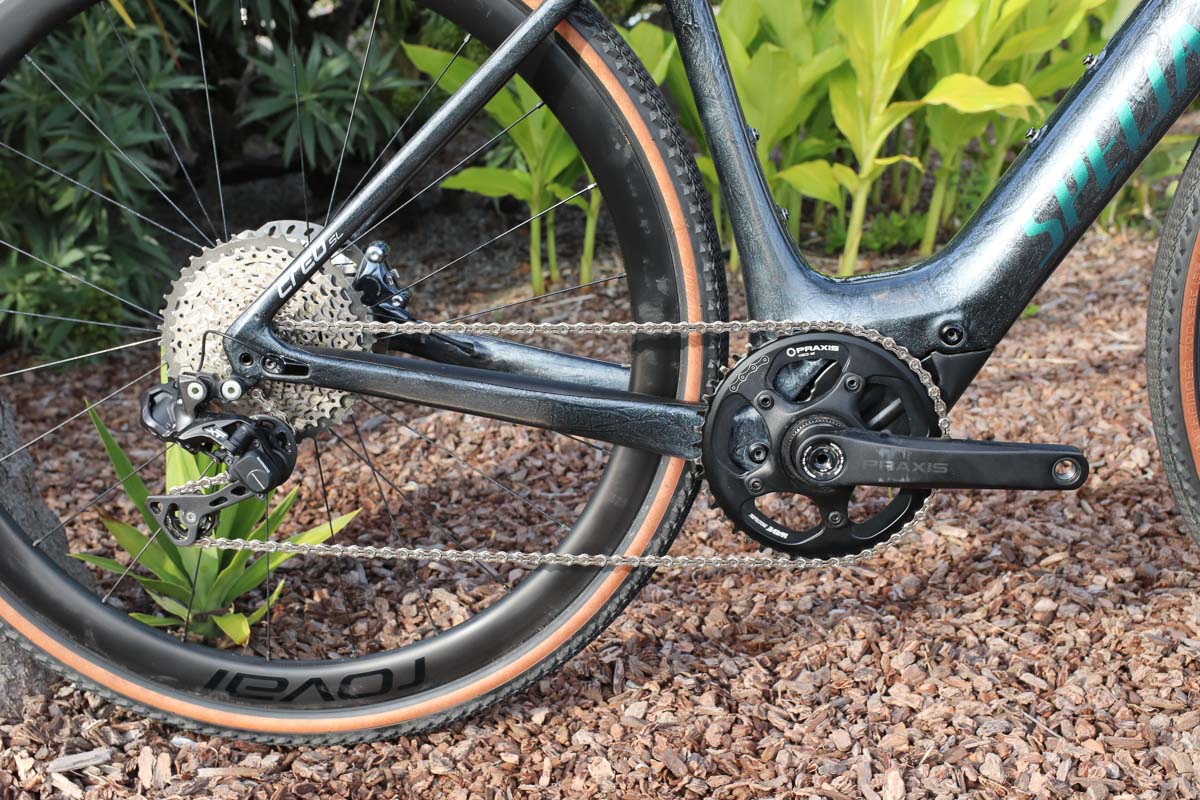 All models of the Turbo Creo SL come with a mixed Shimano drivetrain using road shifters and a mountain bike rear derailleur for extended 1x gear range. Cranks are from Praxis using a 46t ring (carbon or alloy arms depending on the spec level), with an 11-42 cassette.
All models of the Turbo Creo SL come with a mixed Shimano drivetrain using road shifters and a mountain bike rear derailleur for extended 1x gear range. Cranks are from Praxis using a 46t ring (carbon or alloy arms depending on the spec level), with an 11-42 cassette.
The frame uses a 27.2mm diameter seat post, with an X-Fusion Manic dropper post spec’ced on the EVO gravel model. It has 50mm of travel and features a thumb toggle near the left brake lever (shown above).
The frame comes in six sizes, all using 700c wheels (XS geometry information is not yet available). In a new development, the sizing system is called “Beyond Gender”, which eliminates men’s and women’s-specific geometry in favor of one that caters to everyone.
The overall Turbo Creo SL geometry is similar to the Diverge, with the Large size featuring the same stack and reach as a 56cm Diverge. The bottom bracket is higher than the Diverge, with overall BB height being affected by tire size (i.e. gravel tires will raise the BB relative to the ground). Also note that the new frame does not adhere to UCI regulations, with larger sizes using a longer wheelbase for improved handling.
Build Specs, Pricing, and Availability
Four levels of the Turbo Creo SL will be available, all with the same frame, fork, motor, internal battery, and geometry. It will not be released as a frameset at this time.
The Turbo Creo SL Expert ($9,000) has a mix of Shimano Ultegra and XT, Praxis alloy crank arms, and Roval C 38 Disc carbon wheels. Complete weight is 12.8 kg (28.2 lbs).
The Turbo Creo SL Expert EVO ($9,000) is the gravel build, using 38mm Pathfinder Pro tires. It has an Ultegra/XT mix, along with alloy Praxis cranks and Roval C 38 Disc wheels. Gravel-specific upgrades include the X-Fusion dropper post and wider flared Adventure Gear Hover bars. Complete weight is 13.5 kg (29.7 lbs).
The S-Works Turbo Creo SL ($14,000) upgrades to a Dura Ace / XTR build (with an XT cassette), carbon Praxis cranks, and Roval CLX 50 Disc carbon wheels. It also includes one Range Extender battery. Complete weight (sans Extender) is 12.2 kg (26.8 lbs).
Finally, there is a limited run of 250 S-Works Turbo Creo SL Founder’s Edition bikes being made, at the special request of Mike Sinyard. They cost a whopping $17,000, and shave every last gram, bringing the total build weight to 11.9 kg (26.2 lbs).
Key upgrades on the Founder’s Edition include a full XTR cassette, Turbo Cotton 28mm tires, and custom gold-anodized lightweight derailleur pulleys, bolt-on thru axles, and even gold wheel decals. The Founder’s Edition also includes two Range Extender batteries, so you can ride with boost for a long, long time. You even get a Custom SL Kit in the size of your choosing, along with no-charge changes to the touch points to ensure a perfect fit.
The Specialized Turbo Creo SL will be available in bike shops starting late August 2019. The Founder’s Edition can be pre-ordered beginning July 16th, with a 10% deposit due up-front to your Specialized dealer (and product delivery in late 2019).
Stay tuned for our initial ride report after two days of tearing up the roads and trails near Specialized HQ in California.
